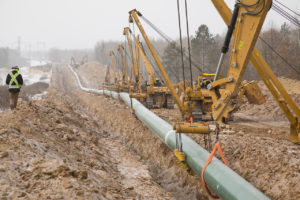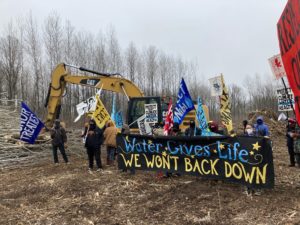 Enbridge’s Line 5, Line 3, ‘Man Camps,’ and the May 12 Deadline
Enbridge’s Line 5, Line 3, ‘Man Camps,’ and the May 12 Deadline
By Craig Manning, originally published on Northern Express May 1
“Shut Down Line 5 Pipeline.” “Keep Oil Out of the Great Lakes.” “No Tunnel.”
If you’ve driven around a northern Michigan neighborhood in the past five years, you’ve probably read these messages on a yard sign. They relate back to a seemingly endless battle between environmental conservationists and Enbridge, the Canadian energy company that operates an extensive pipeline system that runs underneath the Straits of Mackinac.
Critics of the pipeline say that the infrastructure is degrading, with every day bringing the Great Lakes closer to a potentially catastrophic oil leak. Enbridge argues that shutting down the pipeline would set off a domino effect, hindering energy availability and affordability for countless households and industries in the United States and Canada. The debate has raged for years, with everyone from Native American tribes to Michigan municipalities weighing in.
On Nov. 13, Gov. Gretchen Whitmer and Michigan Department of Natural Resources (DNR) Director Dan Eichinger upped the ante in the Line 5 debate: The governor’s office announced that it had “notified Enbridge that the 1953 easement allowing it to operate dual pipelines in the Straits of Mackinac to transport petroleum and other products is being revoked and terminated.”
Whitmer’s office argues that it has grounds to revoke and terminate Enbridge’s easement under Michigan’s “public trust doctrine,” a legal principle that effectively makes the waters of the Great Lakes a public good rather than the property of the state. Under the public trust doctrine, the state has an obligation to protect public water resources “for the use and enjoyment of all.”
“The state found that the 1953 easement violated the public trust doctrine from its inception because the easement does not make the necessary public trust findings,” the press release noted. “Moreover, the state also found that the continued use of the dual pipelines cannot be reconciled with the public’s rights in the Great Lakes and the state’s duty to protect them. Transporting millions of gallons of petroleum products each day through two 67-year-old pipelines that lie exposed along the entire span of a busy shipping channel presents an extraordinary and unacceptable risk. The dual pipelines are vulnerable to anchor strikes, similar dangerous impacts, and the inherent risks of pipeline operations.”
Whitmer’s office also alleged that Enbridge has “repeatedly and incurably violated” the terms of the easement agreement, which requires the company to “exercise due care in operating the pipelines.” Such due diligence requirements include making sure that the underwater pipelines “are physically supported at least every 75 feet” and are shielded by multiple layers of protective coating to prevent corrosion and damage.
ENBRIDGE FIGHTS BACK
Under the action that Whitmer and Eichinger took in November, Enbridge was given a May 12 deadline to shut down Line 5 and cease operations in the Straits of Mackinac. With that deadline just days away, though, oil continues to course through Line 5.
On Nov. 24, Enbridge fired back at Whitmer and Eichinger, announcing that it had filed a federal complaint in the U.S. District Court for the Western District of Michigan “seeking an injunction to stop the State of Michigan from taking any steps to prevent the operation of Line 5.”
“The attempt to shut down Line 5 interferes with the comprehensive federal regulation of pipeline safety and burdens interstate and foreign commerce in clear violation of federal law and the U.S. Constitution,” Enbridge stated in a press release.
The release continued: “A federal agency, the Pipeline and Hazardous Materials Safety Administration (PHMSA), is Enbridge’s safety regulator, not the State of Michigan. In fact, only three months ago the safety of the dual pipelines was reviewed by our regulator and the pipelines were found to be fit for service. The state’s attempt to assume the role of safety regulator through its notice purporting to ‘terminate and revoke’ the easement is improper and unlawful.”
For its part, Enbridge maintains that it has met “all obligations under its agreements with the State of Michigan,” and argues that disrupting Line 5 would create shortages in propane, gasoline, and fuel – affecting heating of homes, gas prices, aviation travel costs, and more.
Six months later, Enbridge Spokesman Ryan Duffy tells Northern Express that the company is still locked in its battle with the state.
“The state has not shown that Enbridge is out of compliance with the easement agreement, and Line 5 continues to operate safely, as determined by PHMSA, the safety regulator of interstate pipelines in the United States.” Duffy said. “The [Whitmer] administration and Enbridge are engaged in court-ordered mediation. Enbridge favors the mediation process and believes it is an opportunity to resolve issues. We take it seriously and are optimistic the process will enable the parties to address key matters in dispute and to find common ground.”
Michigan Attorney General Dana Nessel has argued that the issue is a state’s rights matter and should be decided by a state court rather than a federal one. She’s been joined on that front by 15 attorneys general and two governors of other states, who jointly filed an amicus brief in April stating that, “Despite federal safety regulations for pipelines, states are free to exercise their public trust powers to determine whether and where pipelines may cross their sovereign lands.”
The bottom line? Line 5 might yet be shut down, depending on the outcome of mediation, on further court battles between Enbridge and the state, and on whether U.S. District Judge Janet Neff grants Nessel’s request to have the case sent back to a Michigan court. In the meantime, Michigan residents should expect the May 12 deadline to lapse without any move from Enbridge to shut down Line 5.
THE PARALLEL BATTLE: ENBRIDGE LINE 3
In Michigan, the debate over the 1,098-mile Line 5 — and of Enbridge’s ultimate plan to replace the pipelines under the Mackinac Straits with a new one encased in a protective concrete tunnel is Enbridge’s core claim to fame. In truth, though, Line 5 constitutes just one piece of the Enbridge pipeline system, which moves crude oil from the Athabasca tar sands in northeastern Alberta, Canada to dozens of oil refineries throughout Canada and the midwestern U.S. Line 5 is not the only part of that system causing controversy.
On the contrary, in Minnesota, environmentalists are currently fighting a similar battle over Line 3, a 1,097-mile stretch of pipeline that runs from Edmonton, Alberta to Superior, Wisconsin. (Line 5 hooks into Line 3 in Lake Superior and runs through Wisconsin, under the Mackinac Straits, and through Lower Michigan, to Sarnia, Ontario.) Just as Enbridge is looking to construct a new pipeline and tunnel under the Straits for Line 5, the company is also in the midst of a pipeline replacement project for Line 3. The $4 billion effort will replace 13 miles of pipeline in North Dakota, 337 miles in Minnesota, and 14 miles in Wisconsin. The Wisconsin and North Dakota segments of the replacement project are done; the Minnesota phase began construction in December.
Enbridge claims the replacement of Line 3 is necessary “to maintain our high safety standards, reduce future maintenance activities and create fewer disruptions to landowners and the environment, and restore the historical operating capabilities of Line 3.”
In Minnesota, tensions over Line 3 are so high that Enbridge has reportedly paid approximately $750,000 to cover law enforcement costs related to the pipeline construction — most of them pertaining to protests. The Minnesota Public Utilities Commission (PUC) mandated that Enbridge pay these costs to a “public safety fund” as a contingency of the commission’s decision to approve the pipeline project. The PUC has said its intention was to make sure that Enbridge — not taxpayers — would shoulder any extra law enforcement costs created by the replacement. However, some critics of the pipeline project have argued that the arrangement encourages public law enforcement to act like private security – obliged to protect Enbridge’s interests rather than operate in a neutral fashion.
One of the loudest critics of the PUC safety fund — and of the Minnesota Line 3 project in general — is Winona LaDuke, the co-founder and executive director of Honor the Earth. A Native American nonprofit, Honor the Earth seeks to “create awareness and support for Native environmental issues and to develop needed financial and political resources for the survival of sustainable Native communities.” The organization is helping lead Minnesota’s Line 3 protest movement, arguing that the project Enbridge has billed as a “pipeline replacement” is actually just a plan to build a brand-new pipeline and abandon the old one.
“The company says that they will take care of [the decommissioned pipeline],” LaDuke has said. “But it is not clear that there is any liability from the Enbridge corporation. The worst part is that neither the United States government nor the state of Minnesota has any plan to deal with it. The good news is that the Ojibwe tribes are standing up, and a lot of landowners, county commissioners, and mayors are getting increasingly concerned about who’s going to be liable for Enbridge’s mess.”
“Once the replacement pipeline is operating, the existing Line 3 will be thoroughly cleaned, disconnected, and deactivated,” Duffy said of Enbridge’s decommissioning plans. “Segments under roads and waterways will be capped, sealed, and in many cases filled with gravel so they don’t cave in or carry water. We’ve used this same method across the country when deactivating a pipeline. Our current deactivation-in-place plan represents a longstanding industry best practice that has been recognized by regulators in other jurisdictions as representing the best environmental outcome.”
“Enbridge feels landowners themselves know what is best for their circumstance,” Duffy continued. “As a result, we will work with private landowners to remove the old Line 3 in areas where they determine that to be the best outcome, pending permit approvals. Not surprisingly, in conversation with landowners, we have already heard that many prefer not to disturb their property, and [want to] leave the deactivated line in place.”
PAST PATTERNS, FUTURE RISK
Despite Duffy’s assurance that Enbridge will follow environmental best practices in laying the old Line 3 to rest, critics of the company say Enbridge’s track record speaks louder than its promises. In 2017, the National Wildlife Federation estimated that there had been 29 known spills along the expanse of Line 5, releasing more than one million gallons of oil and natural gas liquids into the ecosystem.
Enbridge is also responsible for the biggest inland oil spill in U.S. history — a record the company set in 2010 when Line 6B spilled 1.2 million gallons of oil into Michigan’s Kalamazoo River.
Local indigenous activist Holly T. Bird says that, more than a decade later, Michigan residents are still paying the price for Enbridge’s “atrocious handling” of the Kalamazoo River Spill. Bird is the co-executive director of Title Track, a northern Michigan nonprofit with a mission of “engaging creative practice to build resilient social-ecological systems that support clean water, racial equity, and youth empowerment.” She is also a private practice attorney in Traverse City and a supreme court justice for the Nottawaseppi Huron Band of Potawatomi Indians.
“It’s still not cleaned up,” Bird said of the Kalamazoo River spill. “People are still sick and dying. [Enbridge] were vastly under-insured to deal with the problem. When they actually settled the lawsuits, it didn’t even touch the harms that were left behind. So we already know that they don’t stand behind their word, as far as being a safe pipeline and taking care of it when a spill happens. People need to remember that their bottom line is money, not trying to take care of the people of Michigan. They don’t have any vested interest in that, except to protect their own investment. Their bottom line is extractive resource energy sourcing and finding the least expensive way to do that. And that is why they’re piping oil through Michigan in the first place: it’s a shortcut is to save them time and money.”
THE ‘MAN CAMP’ PROBLEM
Beyond environmental concerns, Bird notes that pipeline projects have a track record of bringing drugs, violence, sex trafficking, and other criminal activity to the communities they pass through — with indigenous populations, particularly Native women, often becoming collateral damage.
“You get these camps where potentially thousands of male workers come to profit from an oil boom, whether it’s building a tunnel, or building a pipeline, or because there’s a specific oil base there,” Bird explained. “They don’t have an investment in that community. They come in to make money, and potentially stay for a while, and then they leave and go back home. They don’t have their families around them, and so they might be lonely, they might be bored. There’s a great deal of drug use, there’s a great deal of alcohol use, in and around these camps. And then going along with that, there is the victimization of women who are available to them. “
One frequently cited example of the oil industry’s “man camp” problem is the North Dakota Bakken oil boom, which began in the mid-2000s and peaked in 2012. While the boom helped drop North Dakota’s unemployment rate to the lowest in the U.S. for much of the Great Recession, it also created huge populations of transient workers in rural communities – particularly around the Fort Berthold Indian Reservation, which encompasses some of the most productive oil-producing land in the state.
A study of the oil boom showed an 18.5 percent increase in violent crime in North Dakota’s oil boom counties between 2006 and 2012, compared to a 25.6 decrease in counties that weren’t being targeted for oil and gas extraction. In Bakkan regions of North Dakota, the incidence of unlawful sexual conduct and aggravated assault increased 44.8 percent and 70.1 percent, respectively, from 2006 to 2012, compared to declines of 6.7 percent and 4.4 percent in non-Bakkan regions.
The Berthold Reservation, which saw its population temporarily balloon by 30-70 percent over the course of the Bakkan oil boom years, was hit particularly hard: in 2012, tribal police reported “more murders, fatal accidents, sexual assaults, domestic disputes, drug busts, gun threats, and human trafficking cases than in any year before,” per The Atlantic.
Bird is worried that similar spikes in violence could plague rural northern Michigan communities — especially indigenous communities — were Enbridge given the green light to build a new tunnel underneath the Straits. Already, she says natives have been ignored in dealings with Enbridge, given that northern Michigan tribes have treaty rights protecting their access to natural resources – including fishing on the Straits — that should have precluded the state from granting Enbridge’s easement in the first place. Were the state to allow Enbridge to proceed with new Line 5 projects in Michigan, Bird says it would jeopardize Native American women living in close proximity to the Straits.
“I think that the state even having any kind of an agreement with Enbridge is dealing with a company that has unclean hands,” Bird said, noting a February 2021 sex trafficking sting in Minnesota that led to the arrest of seven men – two of them Enbridge contractors. “We elected Whitmer and we elected Nessel because they hung a lot of their campaigns on getting rid of Line 5. We need to hold them accountable [to that].”
When asked about the Minnesota sting, Duffy tells Northern Express that Enbridge “has zero tolerance for all illegal and exploitive behavior” and that the “two individuals who formerly worked for our contractor” had their employment immediately terminated after their arrests. Duffy also says that Enbridge has “developed and implemented a Human Trafficking Prevention Plan in cooperation with several tribal and state entities,” and that the company assisted in the creation of a new sex trafficking awareness campaign in Minnesota, called “Your Call Minnesota.”
For her part, Bird isn’t convinced that the oil and gas industry can make the fundamental changes necessary to protect people, land, and environment. Abuse and harm, she says, are built into the industry’s very DNA.
“These extraction industries, they treat the Earth like they treat women,” Bird said. “They think they can own us, buy us, sell us, trade us, rent us, poison us, rape us, destroy us, and use us as entertainment. That very same mentality that they are using for this industry, it translates to the work that they do. And so anytime that our state is dealing with a company like that, they’re dealing against the public trust, and against the interests of the people of Michigan.”
***Photo above: Opponents to Enbridge’s Line 3 expansion share many of the same fears that opponents of Line 5 do: the potential for spills that would destroy precious water resources, wetlands, and ancestral lands. Although much of the negative attention on Line 5 focuses largely on its direct risk to the Straits, where four miles of the 365-mile pipeline are located underwater, northwest Lower Michigan’s Watershed Council says the onshore portions of Line 5 pose just as much, if not a greater, risk to Michigan’s waters. For instance, the Watershed Center reports that in the Upper Peninsula, Line 5 crosses 16 tributaries within 9 miles of Lake Michigan — 11 of those less than 4 miles from the lake. In the northern Lower Peninsula, Line 5 crosses the Indian River, Little Sturgeon River, Pigeon River, and Upper Black River and traverses within a few miles or less from many inland lakes, including Paradise, Burt, Mullet, and Douglas. Photo courtesy of Enbridge.


